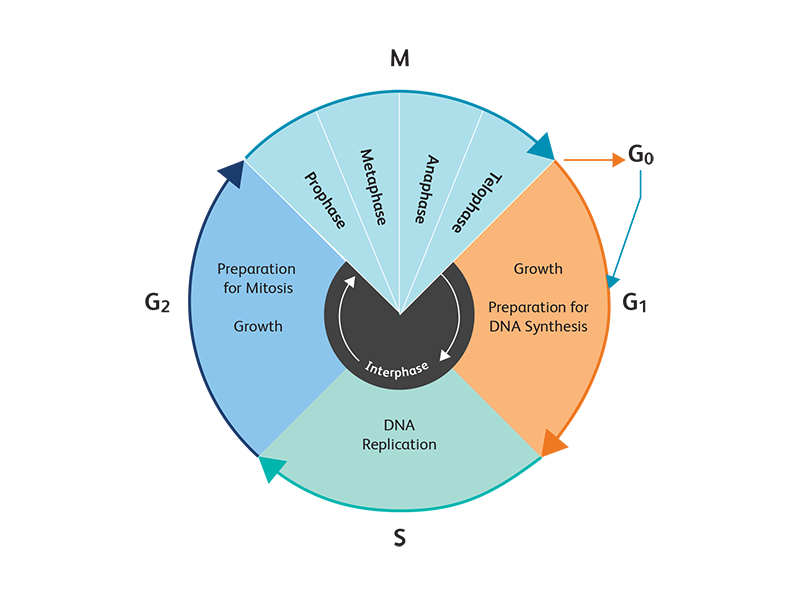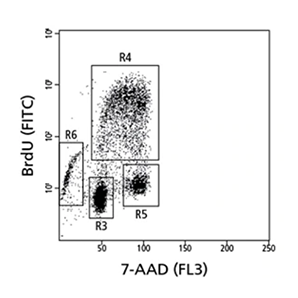-
Account Support
-
Contact
-
Technicalsupport
-
TrainingPage
-
TextAndDownloadTest
-
Protocol Details
-
Protocol Library Component
-
Multi-coloredtablecomponent
-
BDB Protocol Library
-
First Protocol Detail
-
Second Protocol Detail
-
Third Protocol Detail
-
Fourth Protocol Detail
- TrainingDetails
-
RewardsLandingPage
-
TrainingLandingPage
-
Technical Support
-
Bulletpointspage
-
PrivacyPolicy
-
Freeformcomponent
-
Account FAQs
-
Contact
Old Browser

Cell Cycle
Cell growth, replication and division in eukaryotic cells occur according to a highly controlled series of events called the cell cycle. In adaptive immunity, specific T and B lymphocytes undergo clonal expansion (division, proliferation and differentiation) in response to foreign antigenic stimulation. Flow cytometry, immunofluorescence or immunohistochemistry can be used to easily determine the cell cycle status.
Overview of cell cycle and cell proliferation
To help researchers better understand the fundamental cellular mechanisms involved in immunity, inflammation, hematopoiesis, neoplasia and other biological responses, BD Biosciences offers a range of tools including antibodies, kits and systems to measure proliferative responses.
Using flow cytometry, immunofluorescence or immunohistochemistry, researchers can quickly and accurately determine the cell cycle status or tissue localization of individual cells within proliferating populations. These tools include:
- BD Biosciences reagents and BD Cycletest™ Plus Reagent Kit for the analysis of cellular DNA content
- DNA dyes including propidium iodide (PI), 7-aminoactinomycin D (7-AAD), 4′,6-diamidino-2-phenylindole (DAPI) and more
- Antibodies against cyclins, retinoblastoma and phosphorylated histone H3
In adaptive immunity, specific T and B lymphocytes undergo clonal expansion (division, proliferation and differentiation) in response to foreign antigenic stimulation. Cell growth, replication and division in eukaryotic cells occur according to a highly controlled series of events called the cell cycle.
The cell cycle
The cell cycle has two major phases: interphase, the phase between mitotic events, and the mitotic phase, where the mother cell divides into two genetically identical daughter cells. Interphase has three distinct, successive stages. During the first stage called G1, cells monitor their environment and, when the requisite signals are received, the cells synthesize RNA and proteins to induce growth. When conditions are right, cells enter the S stage of the cell cycle and commit to DNA synthesis and replicate their chromosomal DNA. Finally, in the G2 phase, cells continue to grow and prepare for mitosis.


Analysis of cellular DNA content
BD Biosciences offers a wide variety of reagents to study the cell cycle. Reagents include nucleic acid dyes such as propidium iodide (PI) and 7-aminoactinomycin D (7-AAD). In addition, the BD Cycletest™ Plus Reagent Kit includes PI and other reagents to degrade proteins and RNA to allow more precise DNA measurement. The samples are subsequently analyzed using flow cytometry to assess ploidy, identify abnormal DNA stemlines, and estimate the DNA index (DI) and cell cycle phase distributions of stemlines. During the cell cycle phases, DNA levels change, facilitating the use of DNA dyes such as 7-AAD to generate characteristic cellular DNA content profiles (see the figure below).
As cells go through the phases of the cell cycle, proteins such as histone H3 Ser28 become modified or change in expression. To facilitate DNA replication, the histone is modified, opening the chromatin to allow entry of replication machinery. To further support the study of cell cycle, BD Biosciences carries antibodies to these proteins to use for imaging or flow cytometry applications.


| Measures | Reagents | Mechanism | Technology | Sample Types |
|---|---|---|---|---|
| DNA | Cell impermeable dyes: Propidium Iodide (PI), 7-aminoactinomycin D (7-AAD), DAPI, DRAQ7™, BD Via-Probe™ Green Nucleic Acid Stain, BD Via-Probe™ Red Nucleic Acid Stain Cell permeable dyes: Hoechst 33342, Hoechst 34580, DRAQ5™ |
Intercalation into nucleic acid strands | Flow cytometry | Cell impermeable dyes: Fixed, permeabilized and for live/dead discrimination in intact cells Cell permeable dyes: Intact cells (unfixed and unpermeabilized) |
| Newly Synthesized DNA | BrdU, BrdU kits and antibodies to BrdU EdU detection kits |
Bromodeoxyuridine (BrdU) or ethynyl deoxyuridine (EdU) replaces thymidine (T) in dividing DNA. It is then detected by antibodies to BrdU or EdU detection reagents. | Flow cytometry (BrdU and EdU), cell imaging (BrdU and EdU), immunohistochemistry (BrdU only) | Fixed and permeabilized cells, treated tissues (cell imaging, immunohistochemistry only) |
| Protein Level | Antibodies to Ki67, PCNA | Levels increase as a result of proliferation. | Flow cytometry, bioimaging, immunohistochemistry, western blot | Fixed cells, tissues and extracts |
| Protein Level | Antibodies to cyclins, retinoblastoma (Rb), other cell cycle markers | Levels go up and down at different stages of the cell cycle. | Flow cytometry, bioimaging, immunohistochemistry, western blot | Fixed cells, tissues and extracts |
| Protein Modification | Antibodies to phosphorylated histone H3, cyclin dependent kinases (cdk) | Proteins become phosphorylated as a result of proliferation or changes to the cell cycle. | Flow cytometry, bioimaging, immunohistochemistry, western blot | Fixed cells, tissues and extracts |
| Cytokines | BD® CBA (for quantitative detection) | Cytokine production may increase as cells begin to proliferate | Flow cytometry | Tissue culture supernatants, EDTA plasma and serum samples |
-
Application Notes
-
Brochure
-
Product Information Sheets
-
Product List
-
Webinars
For Research Use Only. Not for use in diagnostic or therapeutic procedures.
DRAQ5 and DRAQ7 are trademarks of BioStatus Limited.
Report a Site Issue
This form is intended to help us improve our website experience. For other support, please visit our Contact Us page.